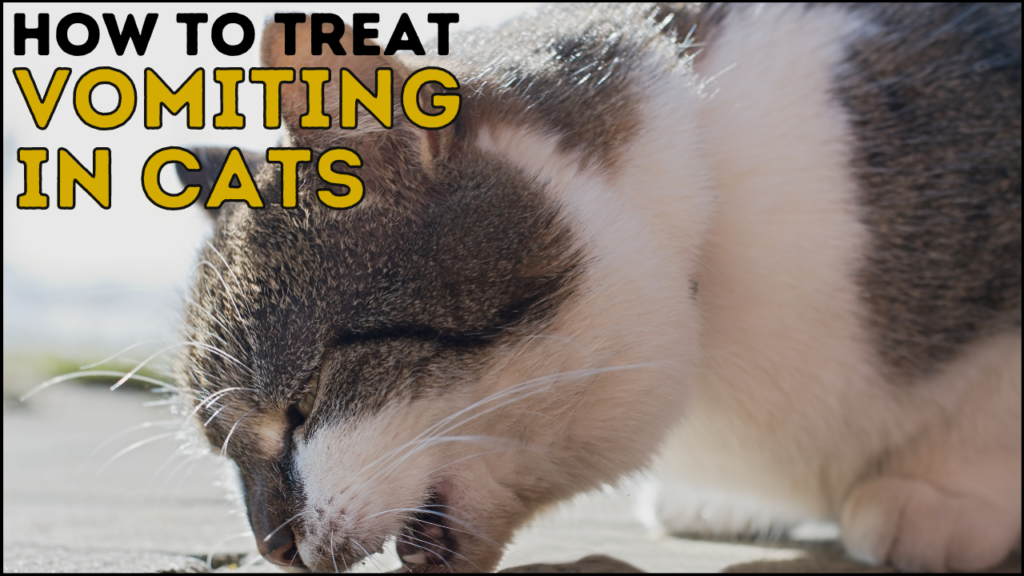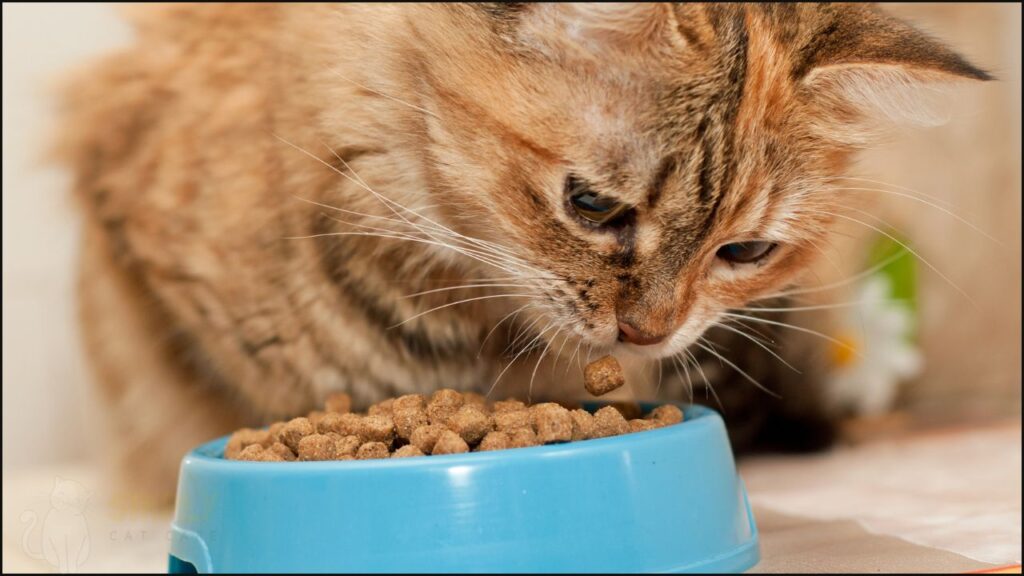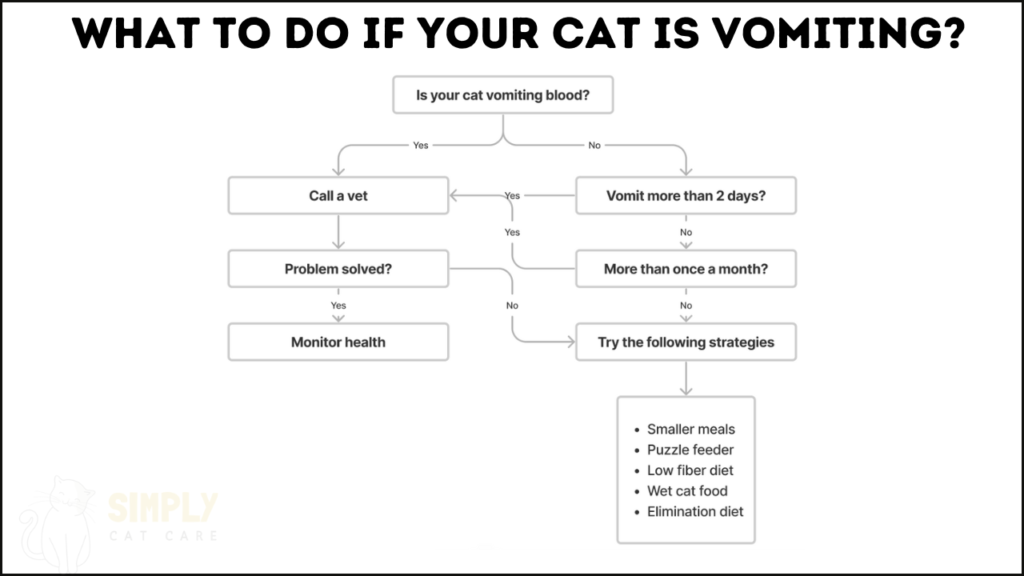Disclaimer: As a Chewy and Amazon affiliate, I earn from qualifying purchases. This does not impact our reviews and comparisons.
Want to find out how to treat a cat that is vomiting?
Food intolerance, allergy, and illness are some common reasons for vomiting.
See a vet if your cat is vomiting blood or the episodes last more than 2 days.
In this article, I’ll go through a step by step guide to help your cat if they’re vomiting.
This will give them the quick help they need.
I am not a veterinarian and I recommend seeking the advice of a vet for any further questions. The advice in this article is not intended as medical advice.

How to Treat a Cat That Is Vomiting
Here’s what to do, step by step.
First, let’s start with possible causes…
What Causes a Cat to Vomit?
- Food allergy
- Food intolerance
- Infection
- Foreign body
- Ulcers
- Neoplasia
- Problems with gut motility
- Pancreatitis
- Hyperthyroidism
That’s a huge range!
For that reason, you want a systematic approach to work out the cause of problem.
Age is key factor to consider.
Senior cats are at a higher risk of vomiting due to disease.
There is a difference between vomiting and regurgitation. Cats can regurgitate after eating or drinking if eating too much.
Benign, but worth addressing with portion control.
Always give cats small serves of food to help as a starting protocol.
Let’s delve deeper into our systematic approach though…
Related:

What Should I Do if My Cat Is Vomiting?
Rule out causes.
First, is the vomiting acute or chronic.
Acute vomiting is anything less than 2-3 days. Like humans, this can happen from time to time.
Causes include:
- Spoiled food
- Hairball
- Eating too much at once
Acute vomiting usually resolves without treatment. Consider seeing a vet, as they can prescribe anti-emetic drugs (e.g. metoclopramide) to give your cat relief.
Cats can experience hairballs, although rarer than commonly thought. Longhaired cats are at greater risk.
What if My Cat Vomits More Than 2 Days?
See a vet.
Chronic vomiting can lead to dehydration and be a sign of serious illness.
Always keep a record of your cats history (e.g. any vomiting episodes and time). This is useful information for vet diagnosis.
- Color
- Presence of hair
- Blood
- Volume
- Any diarrhea
- How long after eating the vomiting occurs
- Travel history
Outdoor cats are at higher risk of infection. This is due to exposure to other feral cats and pests.
Also take photos and videos of your cat vomiting. This is also helpful for vets.

Why Is My Cat Throwing Up Undigested Food?
Food intolerances, allergies, or eating too much.
Food intolerances are anything not related to the immune system. Allergies are immune related.
Some possible causes of intolerance:
- Histamines
- Gluten
- Lactose
- Colorings
- Preservatives
- Flavors
- Lectins
Some cats may be sensitive to grain-based ingredients including:
- Wheat
- Wheat gluten flour
- Barley
Common food allergy sources include:
- Chicken
- Beef
- Dairy
- Eggs
- Wheat
- Fish
As you can see, that’s a huge range of foods and common additives.
The only way to tease out if any of these are to fault is an elimination diet. And that’s best started after ruling out all other causes.
One study showed 49% of cats with gastrointestinal disease showed improvement with diet change. Another found 90% remission with 8 weeks of hypoallergenic diet.
If your vet is at a loss, then consider discussing an elimination diet.
Learn More:
What to Feed a Cat That Is Throwing Up?
- Wet food
- Low fiber (low residue)
- Small serves
As mentioned, food intolerances and allergies are possible issues. This requires an elimination diet.
Fiber is worth limiting. It increases gas in the stomach which can lead to nausea.
Cats eat small meals in nature as carnivores. Fiber doesn’t seem beneficial to a cat.

Frequently Asked Questions
Can Too Many Cat Treats Cause Vomiting?
Unlikely.
Unless your cat has an allergy or food intolerance to ingredients.
Most treats, are dehydrated meat which cats tolerate well.
What Are Some Home Remedies for Cat Vomiting?
Wet cat food.
Avoid leftover foods. Many foods are poisonous to cats.
Avoid essential oils, as they’re toxic to cats.
Related:
What To Do If My Cat Is Vomiting?
Here’s a step-by-step guide:

Conclusion
Food intolerance, allergy, and illness are some reasons for vomiting.
If your cat vomits blood, or the vomiting lasts more than 2 days, see a vet. Keep a good record of events including photos and videos to help with diagnosis.
If the problem persists, consider diet treatment. This includes using smaller meal sizes and an elimination diet.
